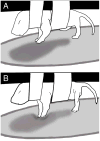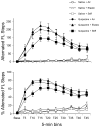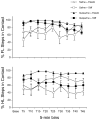Sensory feedback modulates quipazine-induced stepping behavior in the newborn rat
- PMID: 22249136
- PMCID: PMC3294056
- DOI: 10.1016/j.bbr.2012.01.006
Sensory feedback modulates quipazine-induced stepping behavior in the newborn rat
Abstract
Research has shown that sensory feedback modulates locomotor behavior in intact as well as spinal adult animals. Here we examined if locomotor activity ("stepping") in newborn rats is influenced by cutaneous and proprioceptive feedback. One-day-old rats were treated with the serotonergic receptor agonist quipazine (3.0mg/kg) to induce air-stepping behavior or with saline (vehicle control). During stepping, a substrate/floor (elastic, stiff, or none) was placed beneath their limbs so that the feet could make plantar surface contact with a substrate. Pups treated with quipazine showed significantly more alternated fore- and hindlimb steps and plantar paw contact with the substrate, compared to pups treated with saline. Pups also made proportionately less contact with the stiff substrate versus the elastic substrate during stepping. Different types of movements made on the substrate (paw pushes, taps, swipes, and stances) were also characterized. These results indicate that sensory feedback modulates locomotor mechanisms and behavior in perinatal rats.
Copyright © 2012 Elsevier B.V. All rights reserved.
Figures






Similar articles
-
Serotonergic activation of locomotor behavior and posture in one-day old rats.Behav Brain Res. 2016 Apr 1;302:104-14. doi: 10.1016/j.bbr.2016.01.006. Epub 2016 Jan 12. Behav Brain Res. 2016. PMID: 26795091 Free PMC article.
-
Range of motion (ROM) restriction influences quipazine-induced stepping behavior in postnatal day one and day ten rats.Behav Brain Res. 2014 Nov 1;274:365-81. doi: 10.1016/j.bbr.2014.08.028. Epub 2014 Aug 20. Behav Brain Res. 2014. PMID: 25151623 Free PMC article.
-
L-DOPA and quipazine elicit air-stepping in neonatal rats with spinal cord transections.Behav Neurosci. 1997 Aug;111(4):825-33. doi: 10.1037//0735-7044.111.4.825. Behav Neurosci. 1997. PMID: 9267660
-
Dose dependence of the 5-HT agonist quipazine in facilitating spinal stepping in the rat with epidural stimulation.Neurosci Lett. 2008 Jun 27;438(3):281-5. doi: 10.1016/j.neulet.2008.04.080. Epub 2008 Apr 26. Neurosci Lett. 2008. PMID: 18490105 Free PMC article.
-
The role of serotonin in the control of locomotor movements and strategies for restoring locomotion after spinal cord injury.Acta Neurobiol Exp (Wars). 2014;74(2):172-87. doi: 10.55782/ane-2014-1983. Acta Neurobiol Exp (Wars). 2014. PMID: 24993627 Review.
Cited by
-
Spinal mediation of motor learning and memory in the rat fetus.Dev Psychobiol. 2015 May;57(4):421-34. doi: 10.1002/dev.21277. Epub 2015 Mar 4. Dev Psychobiol. 2015. PMID: 25735558 Free PMC article.
-
Prematurely delivered rats show improved motor coordination during sensory-evoked motor responses compared to age-matched controls.Physiol Behav. 2014 May 10;130:75-84. doi: 10.1016/j.physbeh.2014.03.024. Epub 2014 Mar 28. Physiol Behav. 2014. PMID: 24680729 Free PMC article.
-
Posture effects on spontaneous limb movements, alternated stepping, and the leg extension response in neonatal rats.Physiol Behav. 2016 Mar 1;155:122-30. doi: 10.1016/j.physbeh.2015.12.001. Epub 2015 Dec 3. Physiol Behav. 2016. PMID: 26655784 Free PMC article.
-
Development of Locomotor-Related Movements in Early Infancy.Front Cell Neurosci. 2021 Jan 21;14:623759. doi: 10.3389/fncel.2020.623759. eCollection 2020. Front Cell Neurosci. 2021. PMID: 33551751 Free PMC article.
-
Serotonergic activation of locomotor behavior and posture in one-day old rats.Behav Brain Res. 2016 Apr 1;302:104-14. doi: 10.1016/j.bbr.2016.01.006. Epub 2016 Jan 12. Behav Brain Res. 2016. PMID: 26795091 Free PMC article.
References
-
- Altman J, Sudarshan K. Postnatal development of locomotion in the laboratory rat. Anim Behav. 1975;23:896–920. - PubMed
-
- Antri M, Barthe JY, Mouffle C, Orsal D. Long-lasting recovery of locomotor function in chronic spinal rat following chronic combined pharmacological stimulation of serotonergic receptors with 8-OHDPAT and quipazine. Neurosci Lett. 2005;384:162–7. - PubMed
-
- Barbeau H, Rossignol S. The effects of serotonergic drugs on the locomotor pattern and on cutaneous reflexes of the adult chronic spinal cat. Brain Res. 1990;514:55–67. - PubMed
-
- Bekoff A, Lau B. Interlimb coordination in 20-day-old rat fetuses. J Exp Zool. 1980;214:173–5. - PubMed
-
- Bertrand S, Cazalets JR. The respective contribution of lumbar segments to the generation of locomotion in the isolated spinal cord of newborn rat. Eur J Neurosci. 2002;16:1741–50. - PubMed
Publication types
MeSH terms
Substances
Grants and funding
LinkOut - more resources
Full Text Sources

